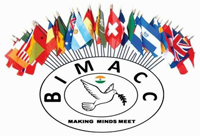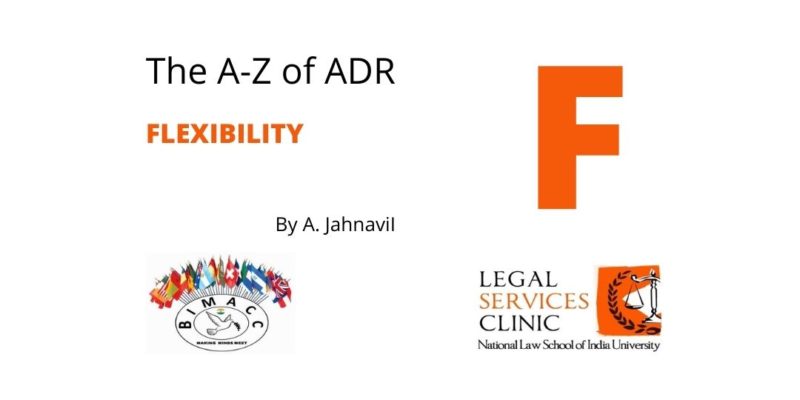
A-Z of ADR: Flexibility
– A. Jahnavi (II Year, NLSIU Bangalore)
The modern process of dispute resolution, Alternative Dispute Resolution (ADR) tries to move beyond the standard model of civil court adjudication. ADR is essentially a method which is used to resolve the disputes without litigation, outside the courtroom. ADR involves procedures like Arbitration, Conciliation, Mediation, etc. The parties which resolve the dispute through ADR are more satisfied with the outcome, mainly due to their direct participation to determine the various terms of the settlement. The major advantages of ADR are that it is cost and time-efficient. This method minimises the conflict among the parties through constructive decisions. There are various modes of Alternative Dispute Resolution, some common types are:
Arbitration:
Here, both parties to a dispute come together with the help of a neutral arbitrator to resolve their disputes. The arbitrator is appointed by both parties, whereas in litigation, the judge is appointed by the court. The decision of the arbitrator is final and binding on both parties, though in some cases it can be appealed. The parties participate in the process and place their side before the arbitrator. In litigation, the lawyers of the parties present their arguments. The litigation process is formal and definite and it needs to be followed strictly whereas arbitration is more flexible. Arbitration has numerous advantages for the parties, trust in the arbitrators, confidentiality of the information (litigation is a public procedure), the time-management and speed of adoption of the solution. The image below explains the difference between both the processes in a nutshell.[1]
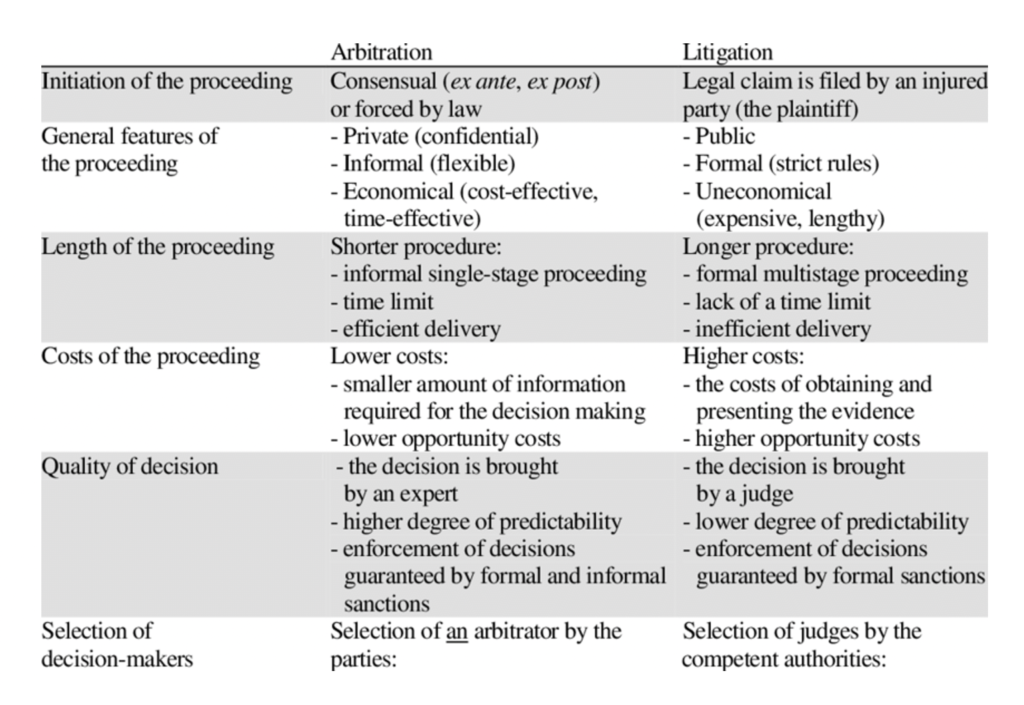
Mediation:
In the process of mediation, the case can be settled without opting for a trial in Court. This process is helpful when both parties are in a deadlock. The parties, lawyers and a neutral third party called the mediator is appointed to resolve the dispute. Here the mediator doesn’t pass judgement or award like a judge or an arbitrator. The mediator listens to both parties and educates them and enables a conversation among them. They talk about the various possibilities and solutions for the dispute rather than making a legally binding decision like in litigation. There is no forced settlement. All parties are actively involved in the process, the mediator focuses on creating mutually agreeable solutions. It allows the parties to settle a case without going to trial which saves a lot of money. The image below explains the advantages of mediation over litigation in a nutshell.[2]
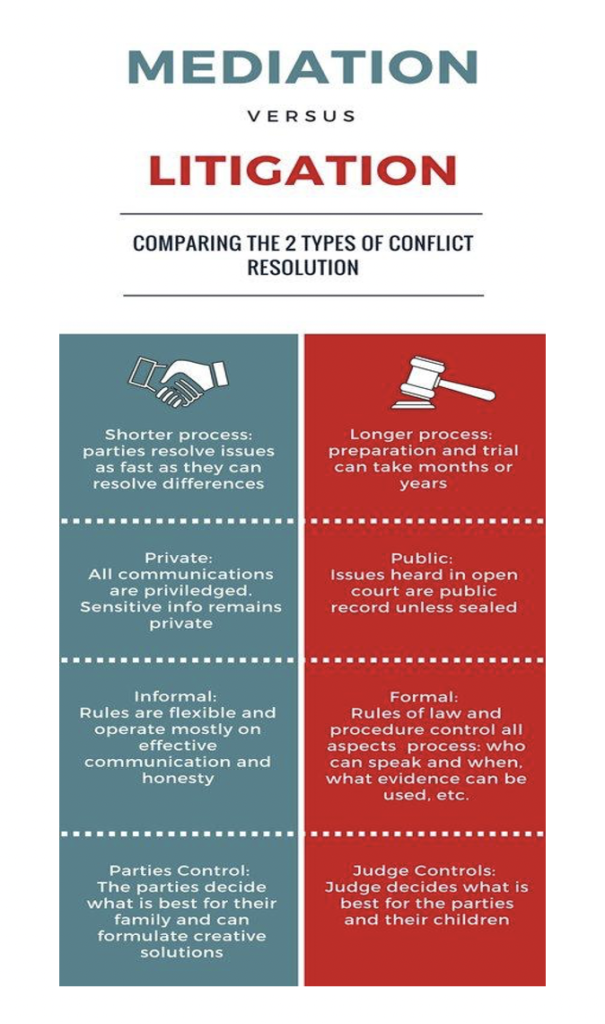
Conciliation:
Conciliation is regulated by the Arbitration and Conciliation Act, 1996. It aims at building a positive relationship among the disputing parties. This process is similar to that of Mediation. This too involves a third party, but they play a more active role in the process of dispute resolution. They provide expert advice to both parties of the dispute and actively encourage them to reach an agreement. However, they remain neutral and don’t provide private counselling to either party. The picture presented below explains the differences between Conciliation and Mediation.[3]
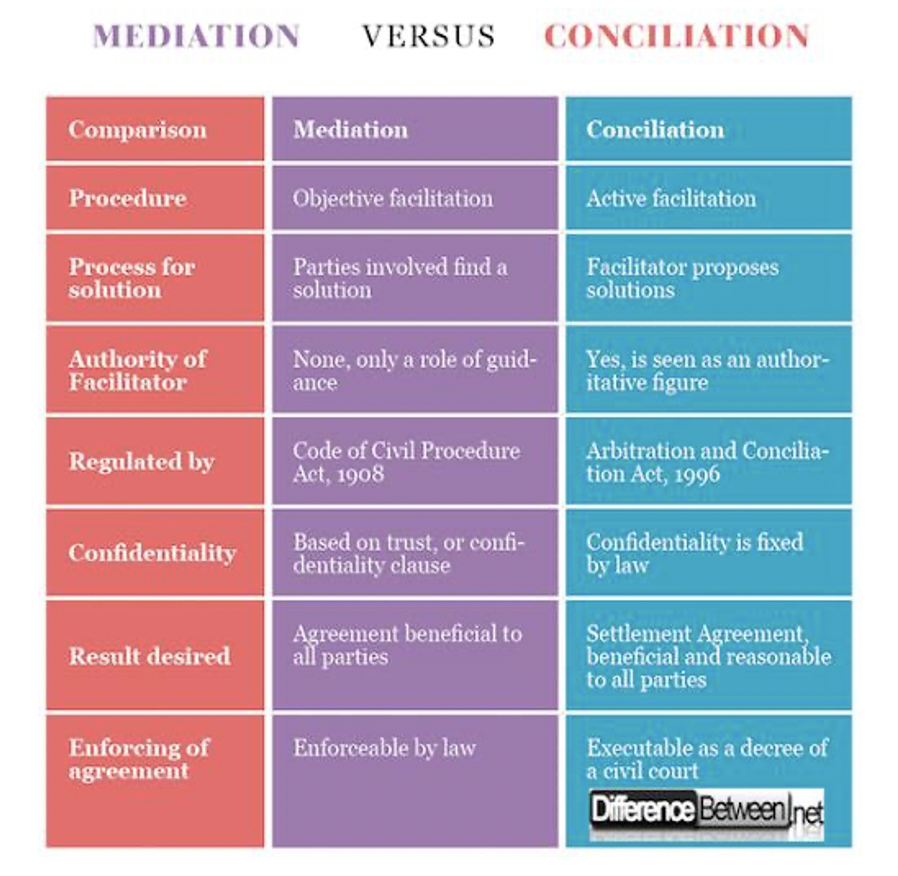
Advantages of Alternative Dispute Resolution:
- The process is fairly simple, the parties do not have to go through lengthy and expensive court hearings.
- The process is cost-efficient, whereas, in lengthy litigation processes, parties have to spend a lot of money.
- The litigation process in the courtroom does not provide for confidentiality. Through the process of ADR, the parties can opt for confidentiality. Hence, the concern for any public impact on the process is non-existent.
- The decisions in the ADR process are often not appealed. Whereas the decisions arrived in the courtroom through litigation are often subject to an appeal which is time-consuming and expensive.
- The decisions are not made by any court-appointed judges and are often adjudicated by neutral professions opted by the consent of both parties.
- The process of ADR often allows for the continuation of good relations among the parties, where the litigation outcomes can dismantle professional relations.
All of the above-mentioned
reasons depict the flexibility of the ADR process. Certainly, ADR is more
flexible than litigation. Hence, opting for ADR is preferable for dispute
resolution.
[1] Aleksandar Mojasevic, ‘Final Offer Arbitration: An Innovative Institution in The ADR Market’ (2017) Facta Universitatis, Series: Law and Politics. 483. <10.22190/FULP1604483M.> accessed 9 August 2020.
[2] Susan Green, ‘Mediation and Litigation’ (Law Office of Susan Green)<https://suzannewgreenlaw.com/pages/litigation-and-mediation> accessed 9 August 2020.
[3]David., ‘The Difference Between Mediation and Conciliation.’ (Difference Between Net, 18 April 2020) <http://www.differencebetween.net/miscellaneous/legal-miscellaneous/the-difference-between mediation-and-conciliation/> accessed on 9 August 2020.
– A. Jahnavi (II Year, NLSIU Bangalore)
A. Jahnavi is a second-year student from the National Law School of India University (NLSIU), Bangalore.
BIMACC expresses its gratitude towards the author and to the members of the Legal Services Clinic, National Law School of India University (NLSIU) for their support in our collaborative efforts to promote ADR with this series titled “A-Z of ADR”. The purpose of this series is to increase the understanding of certain fundamental concepts of Alternative Dispute Resolution.
The Legal Services Clinic is a student-run committee that provides free legal services to the socially and the economically backward sections of the society who have difficulty accessing the judicial system. It also has a mandate of spreading legal awareness and providing free legal assistance to those who cannot afford it.
Website: www.legalservicesclinic.org/
Facebook: @legalservicesclinic
Email: lsc.nlsiu@gmail.com
Phone Number: 073586 73214
Disclaimer: The views and opinions expressed in this blog are those of the author and do not necessarily reflect the official policy or position of BIMACC, any of the members of the Board, or the empanelled neutrals. This blog is for informative purpose only and does not constitute legal advice in any manner whatsoever.
